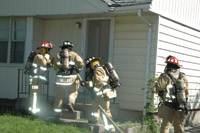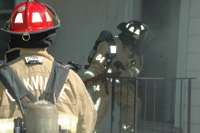
Features
Structural
Training
Trainer’s Corner: March 2011
Survival is the only benchmark of success for a firefighter. The No. 1 key to survival is to keep the fire dragon on a short leash (under control). Although this may sound simple, it is becoming increasingly more difficult to contain a fire to one room in newly constructed buildings.
March 1, 2011
By Ed Brouwer
Survival is the only benchmark of success for a firefighter. The No. 1 key to survival is to keep the fire dragon on a short leash (under control). Although this may sound simple, it is becoming increasingly more difficult to contain a fire to one room in newly constructed buildings.
Controlling the fire is of paramount importance in a mayday situation. Keeping the fire dragon on a short leash is perhaps the largest contributing factor to a successful firefighter rescue. We dare not let go of that leash while performing a rescue; if we do, the fire dragon will take ownership of the fire ground. Your operating guidelines should dictate that the rapid intervention team be deployed to focus on the rescue while other firefighters continue their suppression efforts. This will accomplish two important things. First, it will protect the search-and-rescue operation. Secondly, it will give firefighters something to do toward the rescue effort. If this second objective is not available, firefighters will take things into their own hands in an effort to save their fellow firefighter. This leads to chaos and confusion on the fire ground, and most certainly, more victims.
 |
|
| Ongoing education is the only way to ensure the safety of firefighters on the fire ground. Photos by Laura King |
|
 |
There are a number of reasons for losing control of a fire over which we have very little control, including poor construction, fast-moving fire, severe weather and large fire load. There are reasons for losing control that we can and should address, such as inadequate training, poor PPE, poor suppression tactics, poor communications, lack of manpower and equipment breakdowns (if due to poor upkeep). And yes, sometimes things just go wrong.
The following case studies may help to keep the fire dragon on a short leash. We will look at fire behaviour and building construction. These issues may be familiar to many of you, but as the saying goes, it’s what you learn after you know it all that’s important.
The need to understand fire behaviour never stops. Being able to read smoke can save a firefighter’s life. At the very least, firefighters should be able to recognize the indicators of backdraft, flashover and rollover. When establishing your training calendar, consider matching up fire behaviour training with building construction. Take a tour of your fire protection area. Note the different building types, and, if you have permission, do a walk-through during the different stages of construction in new buildings. Pre-plan for those buildings that give you that cold shiver. Point out any and all firefighter safety concerns.
Do your members know about wooden I-beams (developed 40 years ago and also known as TJI joists or silent floor joists)? They’re lightweight, inexpensive, very strong and used in newer homes everywhere. They’re a perfectly good building material and nothing to be concerned about, unless they catch fire. Then, they can be killers.
Traditional two-by-10 joists can fail in just over 12 minutes, while a wooden I-beam (12-inch) joist can fail in 10 minutes when exposed to the identical fire and dead load tests. A two-minute difference may not sound like much, but to a firefighter in trouble, two minutes can mean the difference between life and death.
Whenever a firefighter fatality occurs, the National Institute of Occupational Safety and Health conducts an investigation into the cause of death. Its task is not to find fault or penalize individuals or jurisdictions, but to render recommendations that are made public. The intent of these investigations is to create a learning process so the fire service as a whole can learn from these events. All reports are available on the NIOSH website at www.cdc.gov/niosh. Here are some examples.
■ Report #F2006-26
Summary: On Aug. 13, 2006, a 55-year-old male career fire engineer (the victim) died and another firefighter was injured after falling through the floor at a residential structure fire. The two had arrived in their ambulance and helped the first-due engine attach a five-inch supply line at approximately 12:27 hours. The engine company was conducting a fast attack on a suspected basement fire, while the ladder company conducted horizontal ventilation. The ambulance crew had advanced to the front of the structure when the incident commander requested they conduct a primary search. The two proceeded to conduct a left-hand search at approximately 12:34 hours. They took a couple of steps to the left, just inside the front door, to conduct a quick sweep. Visibility was near zero with minimal heat conditions. Because of the smoke conditions, they kneeled, sounded the ceramic tile floor, and took one crawling step while on their knees. They heard a large crack just before the floor gave way, sending them into the basement. The basement area exploded into a fireball when the floor collapsed. The fire engineer fell into the room of origin while the firefighter fell on the other side of a basement door into a hallway. The firefighter eventually crawled out of a basement window. The victim’s body was recovered the next day.
■ Type of construction
The structure, built in 1999, was a two-storey, single-family residence of ordinary construction. The floors of the structure involved in this incident consisted of a lightweight wooden parallel-chord truss system and engineered wooden I-beams.
■ Recommendations
Ensure firefighters are trained to recognize the danger of operating above a fire and identify buildings constructed with trusses. Also, consider modifying the current building codes to require that lightweight trusses be protected with a fire barrier on both the top and bottom.
■ Report #F2005-09
Summary: On Feb. 19, 2005, a 39-year-old career fire captain (the victim) died after being trapped by the partial collapse of the roof of a vacant one-storey wood frame dwelling. The house was abandoned and known by residents in the area to be a crack house at the time of the incident. The victim was the captain on the first-arriving engine crew, which was assigned to perform a fast attack, take a hoseline into the house, locate the seat of the fire and begin extinguishment. The one-storey wooden ranch-style house was built in the 1950s and additional rooms had been added at the rear. Crews could see fire venting through the roof at the rear of the house. The captain and a firefighter advanced the initial attack line through the front entrance and made their way toward the rear of the house. Visibility was good in the front of the house but conditions quickly changed as they advanced. The fast-attack crew had just begun to direct water onto the burning ceiling in the kitchen and den areas when the roof at the rear of the structure (over the additions) collapsed, trapping the captain under burning debris. The collapse pushed fire toward the front of the house, quickly igniting carbon and suspended dust particles and combustible gases in the air. This combination sent a fireball rolling toward the front of the structure. Prior to the time of the collapse, two other crews had entered through the front entrance. The rapidly deteriorating conditions following the collapse quickly exposed the other crews to fire, and five firefighters received burns requiring medical attention.
■ Type of construction
The structure was a one-storey, wood frame, ranch-style house that was originally constructed in the 1950s. The house was stick built over a pier and beam foundation.
■ Recommendations
Ensure the incident commander continuously evaluates the risk versus gain when determining whether the fire suppression operation will be offensive or defensive.
Do whatever it takes to get your firefighters to connect fire behaviour with building construction.
You can demonstrate the dangers first hand. Get a four-foot piece of silent floor truss, and a four-foot traditional floor joist (two-by-10). Set them up on two sawhorses, and use two propane blowtorches to apply flame to the underside of each. Consider the differences in their reaction to the flame.
Today’s fires are burning hotter because of the BTUs released by the increasing use of petroleum-based products and thermoplastics. Insulation materials used to conserve energy allow the fire to retain heat and reach flashover in a shorter time frame. The use of unprotected lightweight structural components and engineered fast growth lumber are more susceptible to the effects of today’s hotter fires.
I hope we learn from these case studies. May no firefighter’s ghost say his training let him down. It is becoming more difficult to control the fire dragon. Only by the continued education of our greatest resource, the firefighter, will we be successful. Until next time, keep your head up, stay safe and remember to train like their lives depend on it, because they do.
Ed Brouwer is the chief instructor for Canwest Fire in Osoyoos, B.C., and the training officer for West Boundary Highway Rescue. The 19-year veteran of the fire service is also a fire warden with the B.C. Ministry of Forests, a wildland interface fire suppression instructor/evaluator and a fire-service chaplain. Contact Ed at ed@thefire.ca
Print this page